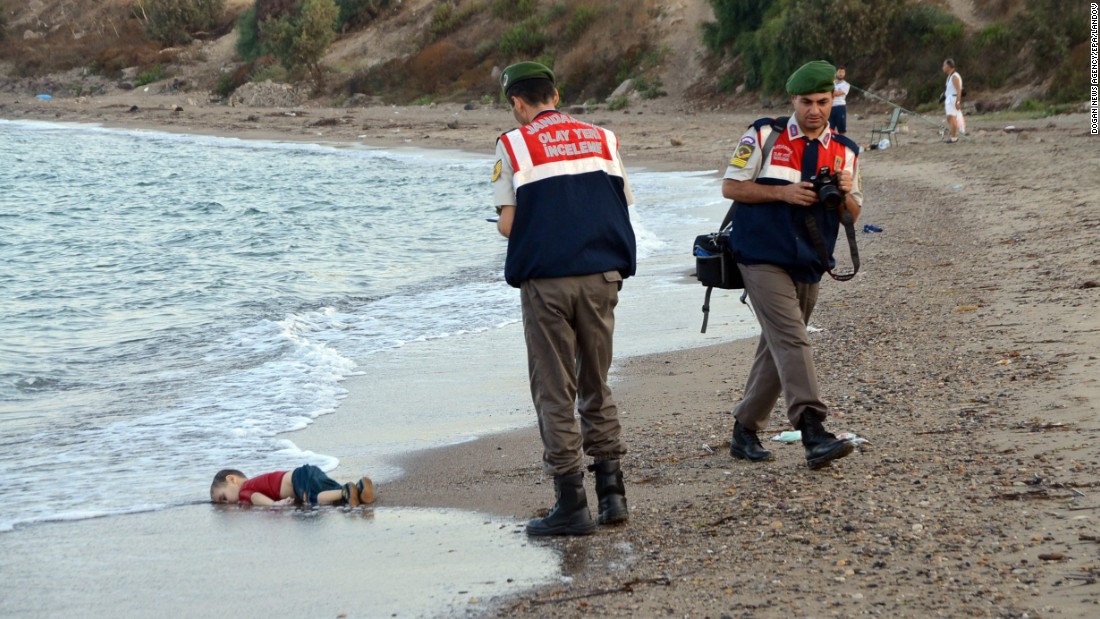The title is a saying that is intended to capture the painful choice between two equally bad options. You may have also heard someone use the phrase “between a rock and a hard place.” Both are idioms used to describe a dilemma.
When I saw this AP (Associated Press) photo in my local newspaper a few days ago I knew that this was one of those photos. It grabbed my attention and forced me to acknowledge a painful reality. Refugees from Syria and other nations under siege by the Islamic State are trying to get to safety, and some are dying in the process. Three-year-old Aylan and his five-year-old brother Galip, along with their mother, were just three of the victims of this tragically failed bid for freedom. To see a lifeless body of a young child is never easy…but is it necessary? That’s a question for journalists and reporters…and media ethicists.
The decision to take the photo or to record audio/video of an event unfolding is fairly straight-forward. Unless you can do something to change the outcome, your journalistic responsibility is to shoot the photo and record the event. Once you get back to the office, away from the urgency of the situation and with the support and counsel of colleagues who are emotionally one step removed from the situation, you can make the decision whether to use some part or all of the material.
As expected the photo was widely distributed, not just by AP but by social media users: some who were shocked by the photo, others by the reality that it represented, and still others by the decision to publish the photo at all. It’s not an easy call. Those who published the photo argued that the shocking nature of the photo may serve a greater purpose. According to the BBC article linked below, the UK newspaper The Independent said it had decided to use the images on its website because “among the often glib words about the ‘ongoing migrant crisis’, it is all too easy to forget the reality of the desperate situation facing many refugees.”
This incident is not without precedent. There have been other photos that have forced us to face harsh realities and the dilemmas inherent in life-and-death moments captured on camera. In an earlier blog post I asked similar questions about photos of men who were seconds away from dying. Years and continents away, a South African photojournalist, Kevin Carter, took a Pulitzer Prize winning photo of a Sudanese child as a vulture waited for her to die. Carter later took his own life. You can read more here and here.
If you believe that these photos should not be published, then you see me as contributing to the problem. I thought about that…and decided to take the risk. I hope that you think deeply about what this picture means, and what it means for you. If we turn away and go back to our Twitter feeds, our video games, or our Netflix movies…or even back to work or whatever else we might be doing this Labor Day weekend…without asking soul-searching questions about our role in the world and how this tragedy might be averted for future Aylans or Galips, everyone loses.
For more information:
- The Telegraph, includes a 90-second video summary of the immigrant problem
- National Public Radio
- BBC World News
- The Washington Post
- CNN

I agree with the view point this article has on the uncomfortable photos.
While the photo brings up uncomfortable feelings, I believe it is effective and necessary. As the old saying goes a picture is worth a thousand words. The photo alone will be just as effective if not more effective because of the emotions that it will bring up. We can read words and not feel a thing. However a photo can bring them up in just a glance. It can be hypothesized that this fact is one of the reasons why people enjoy movies over books.
The photo shown in the blog “Between the Devil and the Deep Blue Sea” definitely gives you an uncomfortable feeling inside.Though through this uncomfortable feeling a message is being sent out. This photo of a lifeless child is shocking to say the least, but it also captures the reality of what is happening in our cruel world. Pictures like this send a message in a more blunt way, but there is really no getting around to revealing the true pains of what other cultures are going through. So this photo is doing justice to the world by capturing the attention of those who are unaware of this situation.
When reading this blog not only did it make me sad to see a child like this but it also made me realize how hard of a job reporters and photographers have. Knowing that what you publish will not only have a negative affect on people but also has a chance at upsetting many can’t be an easy feeling. Personally, I feel like posting a picture like this is necessary because it’s the best way to get your point across, by showing your audience examples on why you feel so strongly towards the subject.